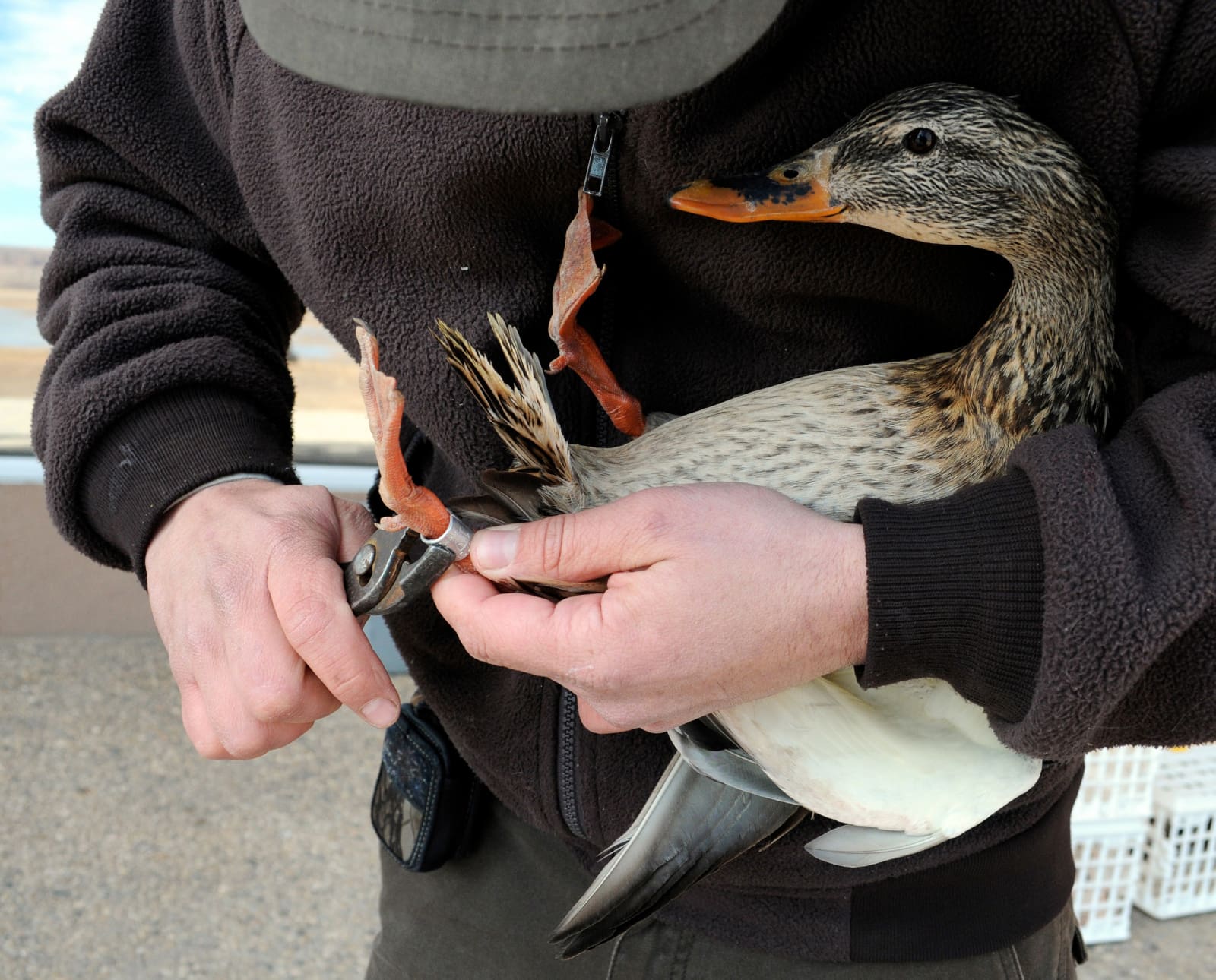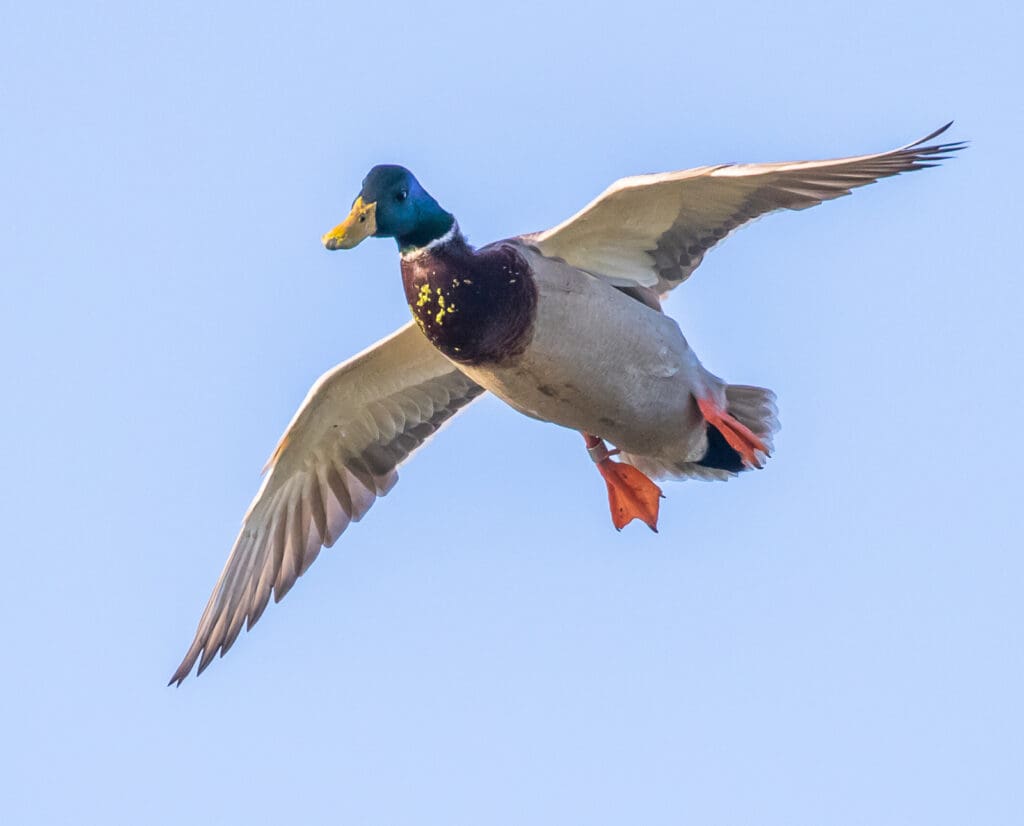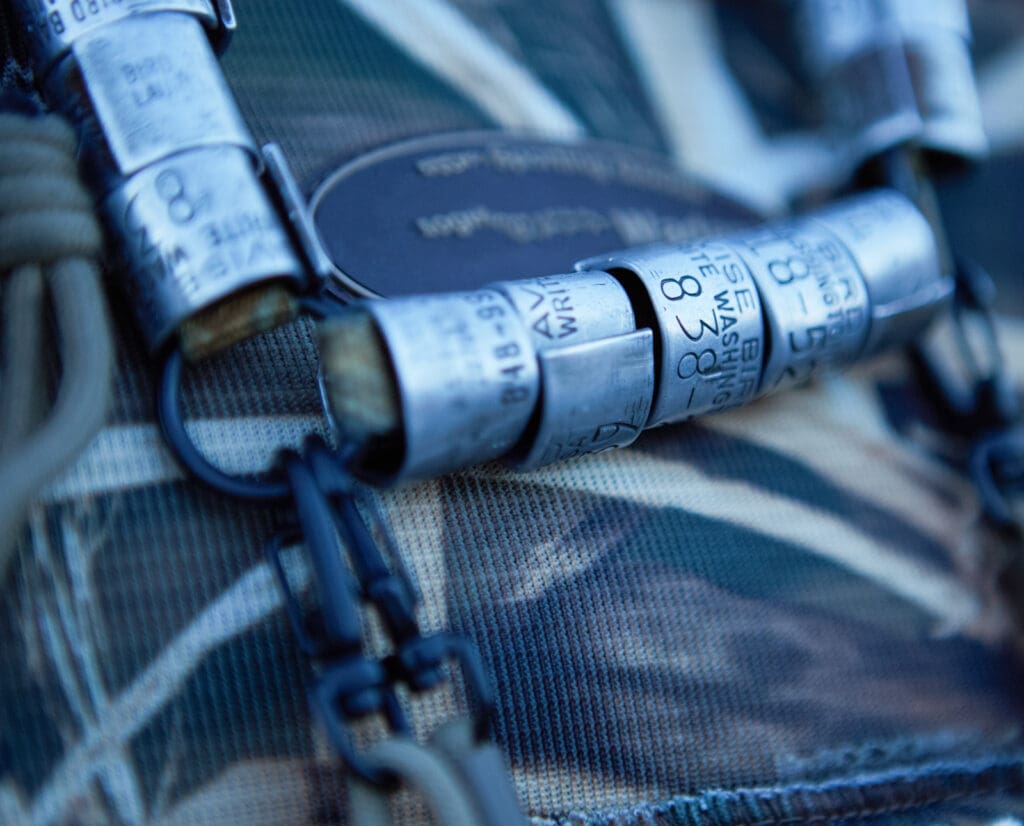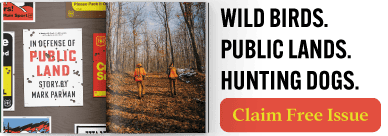Home » Waterfowl Hunting » Why Biologists Band Waterfowl
Why Biologists Band Waterfowl

Mike Adams is an outdoor writer, wildlife biologist, and educator…
Biologists can gain valuable scientific information by banding ducks and geese across the North American landscape.
I’m not one for fashion. The farthest I’ll go is donning a Garmin watch on my wrist and, occasionally, sunglasses to keep stray fly hooks from lodging in my cornea. Without function, style evades me as naturally as mosquitoes avoid a campfire.
But I am a duck hunter. And that means that every winter, I wear a paracord necklace studded with duck calls and bedazzled with what trendy waterfowlers call bling: duck bands.
Over twenty years, I’ve accumulated a paltry number of bands compared to the amount of time I’ve put in the field. But it’s their rarity that imbues bands with significance. I can tell you the exact hunt conditions for every band on my lanyard. I can tell you what creek bend I anchored on, who I was hunting with, and what direction the wind blew. Bands memorialize the memories and etch them into something tangible.
But why were those birds wearing bands in the first place?
Biologists were the ones who put them on. Surely, they didn’t work hours into the night, headlamps strapped to their foreheads, trucks geared into four-wheel drive, trudging through ankle-gripping muck, and wrestling cornfed mallards out of rocket-propelled nets just so a few hunters can show off how much bling they’ve accrued over the years, right?
If not to glam-up hunters, why do biologists band waterfowl?
Why Do Biologists Band Ducks?
The answer lies, at least in part, with the day-to-day duties of folks like Chris Nicolai, a waterfowl scientist for Delta Waterfowl. When Chris isn’t carving ducks or hunting them with one of his yellow Labrador Retrievers, he’s banding them.
“My family gets forced to go on duck banding trips for vacations,” Chris said, “We went to Louisiana over spring break two years ago so we could band mottleds, fulvous, and black-bellies.”
Chris has been involved with waterfowl research for over thirty years. It all started in 1996 when he studied redhead nesting biology as a summer research assistant for Delta Waterfowl. After that, Chris earned his Doctorate while studying black brant. He took a position with the US Fish and Wildlife Service as a migratory bird biologist after graduate school, and today, he’s back with Delta Waterfowl, leading their waterfowl research.
Chris says that, back in the day, bands were used mainly to track birds across migration routes. Tracking leg bands is how biologists discovered the four flyways. Now, with the aid of advanced statistical analyses, waterfowl banding data has become much more useful. Chris breaks down their modern utility into four major categories: harvest estimates, population estimates, the nerdy stuff, and the unexpected.
Waterfowl Harvest Assessments
In 2004, a few months after my tenth birthday, a cold front blasted through the mid-Atlantic, pushing a band of southward-fleeing waterfowl with it. The weather system created prime conditions for hunting. On the tail end of it, I shot my first duck, a mallard drake on Pie Creek. The mallard had orange legs as thick as sausages. Strapped around one was an aluminum band. My dad thought it may have come from Canada. When I dialed the US Geological Survey’s bird banding hotline and gave them the nine-digit code, I learned I had shot the duck just five miles from where it was banded.
Years later, I shot a double band. It sits a little higher on my lanyard than the band from Pie Creek. Two black ducks cupped their wings over a Delaware Bay estuary, and a buddy and I made a clean double. The hen had a band on each leg. The right band read “$100 Reward.” That bird actually did come from Canada, and barring my outdoor writing, it was the only time I’ve ever been paid to hunt.
Those are two of my favorite contributions to the immense dataset managed by the Bird Banding Lab, a subset of the US Geological Survey. Every banded duck exists somewhere in the Bird Banding Lab’s dataset. When folks like Chris Nicolai cinch a band on a mallard, he sends the data to the Bird Banding Lab. When hunters report duck bands from the field, the Bird Banding Lab updates their dataset.
“Duck banding is probably one of the oldest and biggest examples of citizen science,” said Chris, “It helps inform management decisions.”
The dataset serves as a library. Biologists created it, but hunters, reporting their bands and acting as citizen scientists, maintain it. Without band reports, the dataset ends up with loose ends. Potentially valuable information gets lost for banded birds whose ultimate fate remains unknown.
The dataset helps inform biologists on the year-to-year survival of individual birds and approximate rates of death. More importantly, for hunters, the dataset reveals the impacts of management decisions and estimations on the overall harvest of any given species.

Bands Help Estimate Waterfowl Populations
One of the biggest questions looming over every waterfowl biologist’s head is how many birds they’re dealing with. On cold December mornings, I’ve seen black duck flocks so thick they blocked out the sun like passenger pigeons. Sights like that make me wonder how any biologist could estimate the total number of black ducks alive today. Turns out, the task isn’t all that difficult. Chris Nicolai equates it to finding out how many beans are in a jar.
“You grab a fistful of beans out of a jar and put a little marker on each one. That’s your band. Throw it back in the jar and shake it up for a couple of minutes. Then grab another fistful,” Chris said, “That second fistful is your estimate of harvest. A proportion of those beans will have marks.”
That example has three measures. The first is the number of beans you marked and returned to the jar. The second is the number of beans in your second fistful. The third metric is the proportion of beans in the second fistful that have marks. Those numbers can be plugged into a fancy but simple statistical equation called a Lincoln Index. The Lincoln Index accurately equates the total number of beans in the jar.
Biologists leverage the Lincoln Index to estimate waterfowl populations. Instead of marked beans, they put metal leg bands on ducks. The integrity of the equation relies on two things. First, biologists need to band as many ducks as they can. Second, hunters need to report the bands they recover. When that dual effort extends across North America’s four flyways, biologists can accurately estimate how many waterfowl live on our continent.
GPS Backpacks Take Waterfowl Data Collection A Step Further
If you glassed Northeastern salt marsh bays during the winter of 2020, you may have been lucky enough to see the Atlantic brant named Y7. Y7 was plucking grass from an abandoned field outside Atlantic City, New Jersey when a sixty-foot rocket-propelled net flew over her head. State biologists extracted Y7 and the rest of her flock from the net. They all received a standard metal leg band, but only a few received radio backpack units to track their movements. Y7 was fitted with a backpack.
Biologists monitored Y7’s movements through her backpack. A few months after her capture, Y7 migrated from Atlantic City to a golf course on Long Island. Then, she ping-ponged between Adirondack lakes before flying a beeline to James Bay, smack between Quebec and Ontario. After a brief migration break, Y7 summered in Baffin Island. Y7 reversed her route that August and came right back to Atlantic City.
This type of research could help untangle some of the messier nuances of harvest regulations. For example, in the years of Y7’s brant study, biologists had observed decreasing brant numbers. That was reflected in the restrictive limits placed on their harvest. Biologists suspected that the decline might be caused by nest failures. So, they wanted to figure out exactly how brant migrated and where they nested. Research like this provides a solid backbone of data for biologists in charge of setting harvest regulations. Chris Nicolai calls it “the nerdy stuff.”
“In my graduate work, we had a lot of black brant banded,” Chris said, “We knew who they were paired to, how many eggs they laid every year, how many hatched, how many of those got banded, what proportion of those got banded themselves, where they wintered, where they migrated; all this nerdy, in-depth stuff.”
When people ask for science-based management decisions, it’s Chris Nicolai’s nerdy stuff they’re asking for. Without it, biologists and managers can’t accurately identify the underlying causes for changes in waterfowl populations. Even more importantly, the nerdy stuff shines a spotlight into the darkest trenches of waterfowl biology. One of the biggest objectives of the Atlantic brant study, which included Y7, was to find previously unknown breeding colonies.
Pintail Bag Limits Are An Example Science-Based Waterfowl Management
This past year, there was an unexpected upheaval in America’s pintail harvest strategy. The pintail bag limit was set at one bird per day in all four flyways for years. Now, managers have the option to increase that limit three-fold in the 2025-26 hunting season from one bird to three.
The decision is a result of a new integrated population model for the species. Jerome Ford, assistant director of the US Fish and Wildlife Service, said that the new model and the data within it are some of the best science that managers have ever had on pintail.
Chris Nicolai, who celebrates anytime science is used to inform management decisions, chalks the model’s success up to the efforts of his fellow nerds. “It’s all because a bunch of nerds caught a lot of pintails and went through the effort to band them,” he said.
When biologists band ducks, they’re not after every duck. Chris says that in its purest sense, biologists only band birds when there’s a defined reason to. For ducks, only a few species have a specific reason to be banded. Mallards are targeted for banding on all four flyways. Black ducks are targeted on the Atlantic Flyway, and wood ducks are targeted in the southern Mississippi and Atlantic Flyways. There’s no major banding effort for duck species outside of those three. However, biologists often catch more than what they’re after. Incidental bycatch is what leads to bands on other species, such as pintail.
The updated integrated population model, which includes data from bands placed on pintail, suggests that there are probably far more pintail than biologists previously estimated. The new findings have led to potentially liberalized harvest regulations. That’s the importance of incidental banding. It’s also an example of how banding data can sometimes lead to the unexpected.
“We might as well do this just in case we need it in the future,” Chris said while describing why he bands ducks outside his target species, “All these new statistics and new coding capabilities allow you to do things you couldn’t even think of a few years ago. It’s kind of like having a museum. You’re lucky you have this data already archived.”

Duck Hunters May Have “Band Lust”
For all that bands are worth, it’s important to explore the dark side of their existence. It’s something Chris calls band lust. While bands offer hunters an opportunity to become valuable citizen scientists, they also tempt them with greed.
Bands look good on a lanyard. Chris says that, in recent years, there’s been too many stories about hunters going out of their way to target banded birds. Some are even caught poaching. The major problem is that banding data relies on equal effort placed into killing both banded and non-banded birds. Otherwise, the data and analyses become skewed. For that reason, Chris believes we all have a duty.
“Take some pride in that you’re contributing to managing this duck that you’re killing and eating for dinner,” he said. “You’ll want to hunt its relatives next year or even 10 years from now.”
Mike Adams is an outdoor writer, wildlife biologist, and educator hailing from salt marshes of the mid-Atlantic. His work has appeared in numerous outdoor publications, where he uses hunting and fishing narratives to explore deeper issues in conservation or ecology. In the fall, you'll find him on his Barnegat Bay Sneakbox hunting ducks with his dog, Boone. Any other time of year, he's usually out on the salt marsh, catching crabs or fishing for striper.



